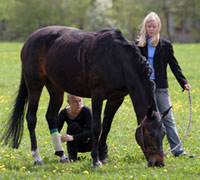 There are many situations that a horse owner might run into such as soft tissue injuries like lacerations and puncture wounds, eye injuries, strains, sprains, other acute lameness issues, colic and fever. Horse owners should have the basic skills required to take care of a horse during an emergency situation until a veterinarian is available.
There are many situations that a horse owner might run into such as soft tissue injuries like lacerations and puncture wounds, eye injuries, strains, sprains, other acute lameness issues, colic and fever. Horse owners should have the basic skills required to take care of a horse during an emergency situation until a veterinarian is available.
Cooperativeness on the part of the animal to accomplish routine acts can be practiced under non-emergency situations in order to succeed in time of crisis.
“This cooperativeness is remindful of school children practicing a fire drill” said Mays. “If something is familiar, it is more easily performed in a crisis situation. If a horse is accustomed to having bandages applied to legs or being loaded in a trailer for no obvious reason, then it won’t seem quite so unusual a request during times of stress or pain.”
In case of emergency, there are a few things that horse owners should have on-hand; especially emergency phone numbers that are readily accessible.
“In a tense moment, the pre-determined numbers can be dialed in order of preference. In case the first choice is unavailable, secondary or tertiary selections have already been made” said Mays. “I also suggest having some bandage materials on hand. Beyond basic leg wrapping techniques, other first aid supplies can vary according to the qualifications of the owner of the horse and the client-patient relationship with the veterinarian.”
Of course, there will be times when it is absolutely necessary that the horse owner calls a veterinarian for assistance, such as if the horse owner feels uncomfortable or inadequate providing the type of care that is necessary, or whenever an animal insurance company is involved.
“Often professional care is provided more quickly when the patient is transported rather than waiting for a busy veterinarian to break away from a practice or hospital environment. However, many vets solely provide ambulatory service and don’t operate from a clinic or hospital facility” said Mays. “Some patients requiring emergency care cannot initially be transported, depending on the experience level of the owner and one’s ability to accurately interpret the situation of the animal in danger. Another factor to consider is the comparison of the facility where the horse located and the facility a veterinarian may provide.”
General anesthesia may be avoided by transporting a young horse with a laceration to a veterinarian’s facility, for example, when the owner’s facility is not equipped with an area for safe restraint. Safety for the animal as well as the people providing the care of the animal is of highest importance.
There are several emergencies that tend to happen frequently to horses. Puncture wounds and lacerations are one of the most common equine medical emergencies. Colic or other issues resulting from too much feed inconsistent feeding are also very common.
“Because horses are naturally inquisitive, eye injuries are another common need for immediate assistance,” says Mays. “Tearing excessively, squinting the eyelids, unnatural desire to stay inside a shaded area when pasture mates are out grazing are all indications of a possible eye problem. When owners are examining their horse, it’s often a good practice to take a look at both sides of the animal no matter how normal one side appears.”
The inquisitive nature of horses can also create other emergency care opportunities. Horses become entrapped in cattle guards, tree forks, narrow chute spaces, and even empty trailers where the wind has assisted in closing the gates of the trailer.
“From a veterinarian’s point of view, it’s very frustrating to be invited to attend an animal situation that has already progressed several days because the owner’s decision to provide therapy has proven a mistake” said Mays. “Please don’t wait too long and always listen to your conscience.”
Further Reading
Wound Care Chart
Equine First Aid Kit







Great article.We can all learn a little more on vet care-especially how to handle emergencies.
All good to know.